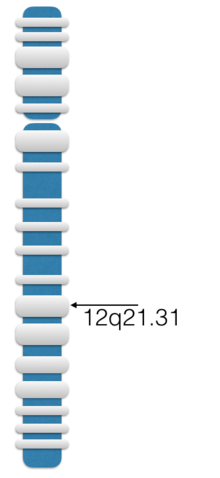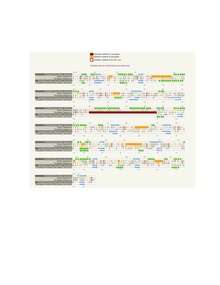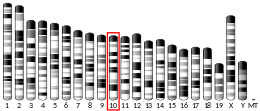Leucine-rich repeats and iq motif containing 1
Leucine-rich repeats and IQ motif containing 1 is a protein that in humans is encoded by the LRRIQ1 gene. [5] The protein is likely a nuclear encoding mitochondrial protein[6] and is found in all Metazoans.[7]

| LRRIQ1 | |||||||||||||||||||||||||
|---|---|---|---|---|---|---|---|---|---|---|---|---|---|---|---|---|---|---|---|---|---|---|---|---|---|
| Identifiers | |||||||||||||||||||||||||
| Aliases | LRRIQ1, leucine rich repeats and IQ motif containing 1 | ||||||||||||||||||||||||
| External IDs | MGI: 1922228 HomoloGene: 46007 GeneCards: LRRIQ1 | ||||||||||||||||||||||||
| |||||||||||||||||||||||||
| |||||||||||||||||||||||||
| Orthologs | |||||||||||||||||||||||||
| Species | Human | Mouse | |||||||||||||||||||||||
| Entrez | |||||||||||||||||||||||||
| Ensembl | |||||||||||||||||||||||||
| UniProt | |||||||||||||||||||||||||
| RefSeq (mRNA) | |||||||||||||||||||||||||
| RefSeq (protein) | |||||||||||||||||||||||||
| Location (UCSC) | Chr 12: 85.04 – 85.26 Mb | Chr 10: 103.05 – 103.24 Mb | |||||||||||||||||||||||
| PubMed search | [3] | [4] | |||||||||||||||||||||||
| Wikidata | |||||||||||||||||||||||||
| |||||||||||||||||||||||||

Gene
LRRIQ1 is mapped on chromosome 12, at 12q21.31in humans. LRRIQ1 is near ALX1 on the positive strand, and TSPAN19 and SLC6115 on the negative strand. It covers 208.78kb, from 85430099 to 8563881 on the direct strand. The gene contains 36 exons.[8]
mRNA
The gene contains 31 distinct introns, and the transcript produces 10 different mRNAs. LRRIQ1 has two validated alternative polyadenylation sites. The most common isoform consists of 5,460 base pairs in length, and includes 28 of the total 29 exons.[7] Primates have an elongated 3’ end compared to other mammalian species. Reptiles, birds, and fish also have a truncated 3’end, compared to primate transcripts.[9]
Protein
The protein is a nuclear encoding mitochondrial protein.[6] The protein in humans has 1760 amino acids. The protein is considered largely neutral, though 17% of the primary structure is composed of the hydrophobic leucine-rich repeats.[10]
The leucine-rich repeat forms a structural horseshoe shape, which encourages protein-protein interactions. The most common translated isoform has a predicted molecular weight of 199.3 kdal.[5][10] Compared to an average of human sequences, the internal composition is rich in Leucine, Glutamic Acid, and Lysine.[11]
Domains and Motifs
LRRIQ1 contains an IQ calmodulin-binding motif found in one isoform. The isoform contains three copies and serves as a binding site for Calmodulin or CaM-like proteins.[5] The Leucine-Rich Repeat domain is found in three isoforms of LRRIQ1. LRRIQ1 contains 4 Leucine Rich Repeats (LRR). The LRR motif provides a structural frame work for the formation of protein-protein interactions, forming a coiled horseshoe shape.[10]
Homology
There are no known paralogs of LRRIQ1 detected in humans.
There are many orthologs of LRRIQ1. Orthologous LRRIQ1 is found in all metazoans. LRRIQ1 is not found in Plants, Bacteria, Archaea, Fungi, or protists. The most distant homolog is found in Drosophila melanogaster [9](estimated time of divergence 847 million years ago[12]). The IQ-containing motif and Leucine-rich repeats domains are conserved in Drosophila.
Conservation
The LRRIQ1 gene has been shown to be highly conserved. The gene has true orthologs throughout the taxa mammal and is found in all Metazoans. The time of divergence versus the corrected % divergence (m) was plotted with samples from human, gorilla, domesticate cat, bison, orca whale, Arabian camel, domestic horse, African Bush Elephant, Bald Eagle, Adelie Penguin, Japanese Gecko, Carolina Anole, and Western Clawed Frog.[9][12] To make slopes for Fibrinogen (considered a comparatively rapidly evolving protein) and Cytochrome C (comparatively slower), Xenopus tropical, Xenopus laevis, Takifugu rubripes, and Bos Taurus were utilized for comparison.
Expression
LRRIQ1 is lowly expressed (0.6 times the average gene) in lung, testis, epithelial tissue, pooled germ cell tumors, brain tissues, embryonic tissues, and adipose tissues.[7]
Interacting Proteins
The presence of the Leucine-Rich Repeat motif provides structural framework for protein-protein interactions. HES4 is the only identified protein that interacts with LRRIQ1.[13]
HES4, is a transcription factor found in humans. The protein binds DNA on N-box motifs.[14]
Clinical significance
To date, the clinical significance of this gene is not known.
References
- GRCh38: Ensembl release 89: ENSG00000133640 - Ensembl, May 2017
- GRCm38: Ensembl release 89: ENSMUSG00000019892 - Ensembl, May 2017
- "Human PubMed Reference:". National Center for Biotechnology Information, U.S. National Library of Medicine.
- "Mouse PubMed Reference:". National Center for Biotechnology Information, U.S. National Library of Medicine.
- "Entrez Gene: Leucine-rich repeats and IQ motif containing 1". Retrieved 2016-03-29.
- Hart, Gerald W.; Akimoto, Yoshihiro (2009-01-01). Varki, Ajit; Cummings, Richard D.; Esko, Jeffrey D.; Freeze, Hudson H.; Stanley, Pamela; Bertozzi, Carolyn R.; Hart, Gerald W.; Etzler, Marilynn E. (eds.). The O-GlcNAc Modification (2nd ed.). Cold Spring Harbor (NY): Cold Spring Harbor Laboratory Press. ISBN 9780879697709. PMID 20301273.
- mieg@ncbi.nlm.nih.gov, Danielle Thierry-Mieg and Jean Thierry-Mieg, NCBI/NLM/NIH. "AceView: Gene:LRRIQ1, a comprehensive annotation of human, mouse and worm genes with mRNAs or ESTsAceView". www.ncbi.nlm.nih.gov. Retrieved 2016-05-03.
- "LRRIQ1 leucine-rich repeats and IQ motif containing 1 [Homo sapiens (human)] - Gene - NCBI". www.ncbi.nlm.nih.gov. Retrieved 2016-05-03.
- "BLAST: Basic Local Alignment Search Tool". blast.ncbi.nlm.nih.gov. Retrieved 2016-05-03.
- Kelley, Lawrence. "PHYRE2 Protein Fold Recognition Server". www.sbg.bio.ic.ac.uk. Retrieved 2016-05-03.
- "ProMoST: Protein Modification Screening Tool | proteomics.mcw.edu". proteomics.mcw.edu. Retrieved 2016-05-03.
- "TimeTree :: The Timescale of Life". timetree.org. Retrieved 2016-05-03.
- "mentha: the interactome browser". mentha.uniroma2.it. Retrieved 2016-05-03.
- mieg@ncbi.nlm.nih.gov, Danielle Thierry-Mieg and Jean Thierry-Mieg, NCBI/NLM/NIH. "AceView: Gene:HES4, a comprehensive annotation of human, mouse and worm genes with mRNAs or ESTsAceView". www.ncbi.nlm.nih.gov. Retrieved 2016-05-03.
Further reading
- Rose JE, Behm FM, Drgon T, Johnson C, Uhl GR (2010). "Personalized smoking cessation: interactions between nicotine dose, dependence and quit-success genotype score". Mol. Med. 16 (7–8): 247–53. doi:10.2119/molmed.2009.00159. PMC 2896464. PMID 20379614.



